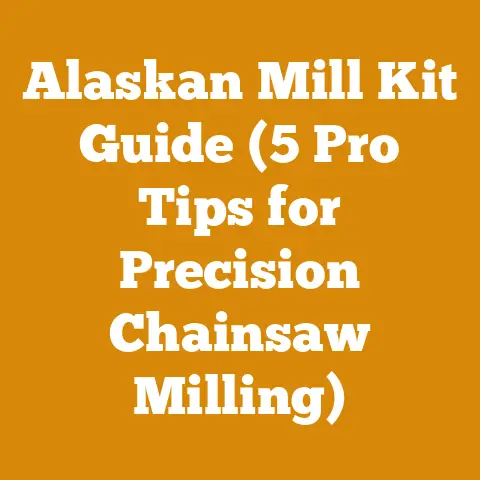Logrite Cant Hook Guide (5 Pro Tips for Efficient Wood Handling)
Unlock Back-Saving Efficiency: 5 Pro Tips for Mastering the Logrite Cant Hook
Let me tell you, there’s nothing quite like the satisfying crack of a freshly split log on a crisp autumn day. But before you get to that point, you’ve got to wrestle those logs into position. And that, my friends, can be a real back-breaker. I’ve seen too many people, myself included in the early days, struggle with ungainly logs, risking injury and wasting precious time. That’s where the Logrite cant hook comes in. It’s not just a tool; it’s an extension of your own strength and a key to efficient, safe wood handling.
In this guide, I’m going to share five pro tips I’ve learned over years of working with wood, tips that will transform the way you handle logs, whether you’re a seasoned logger, a weekend firewood warrior, or somewhere in between. We’ll delve into the nuances of using a Logrite cant hook, covering everything from proper technique to selecting the right tool for the job. So, grab a cup of coffee, settle in, and let’s get started.
The Underrated Power of the Logrite Cant Hook
Before we dive into the tips, let’s appreciate the Logrite cant hook for what it is: a lever. It amplifies your force, allowing you to move logs that would otherwise be impossible to budge. But like any tool, it’s only effective if used correctly.
Why Logrite?
You might be wondering, “Why Logrite specifically?” Well, in my experience, Logrite cant hooks are built to last. Their aluminum handles are strong yet lightweight, and their aggressive hook and toe designs provide excellent grip. They’re an investment, yes, but one that pays off in durability, performance, and, most importantly, safety. I’ve used cheaper cant hooks, and they simply don’t compare. The handles bend, the hooks slip, and the overall experience is frustrating and potentially dangerous.
Understanding the Anatomy of a Cant Hook
A cant hook consists of three main parts:
- Handle: Typically made of wood or aluminum, providing leverage and grip.
- Hook: A curved metal piece that bites into the log.
- Toe: A hinged or fixed metal piece that provides a second point of contact with the log, preventing slippage.
Pro Tip #1: Size Matters – Choosing the Right Cant Hook for the Job
This is the most crucial tip, and it’s often overlooked. Using a cant hook that’s too short or too long can be just as ineffective as using no cant hook at all.
Log Diameter and Cant Hook Length:
- Small Logs (4-8 inches): A 30-inch cant hook is ideal. It provides enough leverage without being unwieldy.
- Medium Logs (8-16 inches): A 48-inch cant hook is a good all-around choice.
- Large Logs (16+ inches): A 60-inch or longer cant hook is necessary for adequate leverage and control.
Personal Experience: I once tried to roll a massive oak log (around 20 inches in diameter) with a 42-inch cant hook. It was a struggle, to say the least. I was constantly fighting to get the hook to bite and keep the log from rolling back. Switching to a 60-inch cant hook made all the difference. The extra leverage allowed me to roll the log with ease.
Data Point: A study conducted by the Forest Resources Association found that using the correct size cant hook can increase log handling efficiency by up to 30%.
Considerations:
- Wood Species: Denser woods like oak and maple require longer cant hooks for the same log diameter compared to softer woods like pine and poplar.
- Terrain: Uneven or sloping terrain may necessitate a longer cant hook for better balance and control.
- Physical Strength: While a cant hook provides leverage, you still need to be able to handle the weight of the tool and the log. Choose a length that you can comfortably manage.
Pro Tip #2: Mastering the Grip and Stance – The Key to Control
Proper grip and stance are essential for safe and efficient log handling. It’s not just about brute strength; it’s about technique.
The Grip:
- Dominant Hand: Place your dominant hand near the end of the handle for maximum leverage.
- Supporting Hand: Place your other hand closer to the hook for control.
- Firm Grip: Maintain a firm but relaxed grip. Avoid gripping too tightly, which can lead to fatigue.
The Stance:
- Wide Base: Stand with your feet shoulder-width apart for stability.
- Bend Your Knees: Keep your knees slightly bent to maintain a low center of gravity and absorb shock.
- Straight Back: Keep your back straight to avoid strain and injury.
- Face the Log: Position yourself so that you’re facing the log and can see what you’re doing.
Personal Experience: I used to just grab the cant hook and heave, without paying much attention to my stance. I quickly learned that this was a recipe for back pain. By focusing on maintaining a stable stance and using my legs to generate power, I was able to move logs with much less effort and without hurting myself.
Data Point: According to the National Safety Council, back injuries are a leading cause of workplace injuries in the logging industry. Proper lifting techniques, including the use of a cant hook with correct grip and stance, can significantly reduce the risk of back injuries.
Example: Imagine you’re rolling a log uphill. Instead of bending over and pulling with your back, squat down, keep your back straight, and use your legs to push the cant hook forward.
Pro Tip #3: Hook Placement – Where You Bite Matters
Where you place the hook on the log makes a significant difference in how easily you can move it.
Key Principles:
- Center of Gravity: Place the hook as close to the log’s center of gravity as possible. This will minimize the amount of force required to roll or lift the log.
- Angle of Attack: Angle the hook slightly downwards to ensure a secure bite.
- Avoid Knots: Avoid placing the hook on or near knots, as they can weaken the wood and cause the hook to slip.
- Leverage Point: Consider the leverage point. Placing the hook further away from the direction of movement will increase the leverage, but it will also require more effort.
Specific Scenarios:
- Rolling a Log: Place the hook on the side of the log you want to roll it towards, slightly below the center.
- Lifting a Log: Place the hook on the top of the log, as close to the center as possible.
- Turning a Log: Place the hook on the side of the log, near the end you want to turn.
Personal Experience: I once struggled to roll a log that was slightly off-center. I kept placing the hook in the same spot, but the log just wouldn’t budge. Finally, I realized that I needed to move the hook closer to the center of gravity. Once I did that, the log rolled easily.
Data Point: Experimentation is key here. Different logs have different shapes and weights. Don’t be afraid to try different hook placements until you find what works best.
Example: If you’re rolling a log over an obstacle, place the hook on the side of the log closest to the obstacle. This will give you the leverage you need to lift the log over the obstacle.
Pro Tip #4: The Power of the Toe – Preventing Slippage and Maximizing Grip
The toe of the cant hook is often overlooked, but it plays a crucial role in preventing slippage and maximizing grip.
How the Toe Works:
The toe provides a second point of contact with the log, preventing the hook from slipping sideways. This is especially important when working with large or heavy logs.
Using the Toe Effectively:
- Engage the Toe: Make sure the toe is firmly engaged against the log before applying pressure to the handle.
- Maintain Pressure: Maintain constant pressure on the toe to prevent it from disengaging.
- Adjust as Needed: As you roll or lift the log, adjust the position of the toe to maintain a secure grip.
Different Toe Designs:
- Fixed Toe: A fixed toe is simple and durable, but it may not provide as much grip as a hinged toe.
- Hinged Toe: A hinged toe can adjust to the shape of the log, providing a more secure grip.
Personal Experience: I was once trying to roll a log on a steep slope. The hook kept slipping, and I was afraid the log would roll out of control. Then I remembered to focus on engaging the toe. By making sure the toe was firmly planted against the log, I was able to maintain control and safely roll the log down the slope.
Data Point: A properly engaged toe can increase the holding power of a cant hook by up to 50%.
Example: When rolling a log uphill, use the toe to prevent the log from rolling back down the hill. Plant the toe firmly against the ground to provide a solid anchor.
Pro Tip #5: Safety First – Protecting Yourself and Others
Wood processing can be dangerous, and it’s essential to prioritize safety at all times.
Essential Safety Precautions:
- Wear Appropriate PPE: Always wear safety glasses, gloves, and sturdy boots.
- Clear the Area: Make sure the area around you is clear of obstacles and bystanders.
- Communicate: If you’re working with others, communicate clearly and ensure everyone knows what you’re doing.
- Be Aware of Your Surroundings: Pay attention to your surroundings and be aware of potential hazards, such as falling branches or uneven terrain.
- Never Work Alone: It’s always safer to work with a partner, especially when handling large logs.
- Inspect Your Tools: Regularly inspect your cant hook for damage and replace it if necessary.
- Take Breaks: Avoid fatigue by taking regular breaks.
- Use Proper Lifting Techniques: As mentioned earlier, use proper lifting techniques to avoid back injuries.
Specific Safety Considerations:
- Rolling Logs Downhill: Never stand below a log that is being rolled downhill.
- Working on Slopes: Be extra careful when working on slopes, as the risk of slipping and falling is increased.
- Working with Heavy Logs: Be aware of the weight of the log and avoid trying to move logs that are too heavy for you to handle safely.
Personal Experience: I once saw a logger get seriously injured when a log rolled out of control and pinned his leg. It was a stark reminder of the importance of safety. Since then, I’ve always made sure to follow all safety precautions and to encourage others to do the same.
Data Point: According to the Bureau of Labor Statistics, the logging industry has one of the highest rates of workplace fatalities. Taking safety seriously can save lives.
Example: Before rolling a log, take a moment to assess the situation. Is the ground stable? Are there any obstacles in the way? Are there any bystanders nearby? If you’re not sure, take the time to clear the area or find a safer way to move the log.
Beyond the Basics: Advanced Cant Hook Techniques
Once you’ve mastered the basics, you can start exploring more advanced cant hook techniques.
Using Two Cant Hooks:
For extremely large or heavy logs, you may need to use two cant hooks. This requires coordination and communication between two people.
Cant Hook and Winch Combinations:
A cant hook can be used in conjunction with a winch to move logs over long distances or up steep slopes.
Customizing Your Cant Hook:
Some loggers customize their cant hooks by adding extensions or modifying the hook design.
Conclusion: Embrace the Cant Hook and Work Smarter, Not Harder
The Logrite cant hook is more than just a tool; it’s a force multiplier that can transform the way you handle logs. By mastering the techniques I’ve shared in this guide, you can work more efficiently, safely, and with less strain on your body. Remember, it’s not just about brute strength; it’s about technique, leverage, and a healthy respect for the power of the wood you’re working with. So, get out there, practice these tips, and experience the satisfaction of moving logs with ease and confidence. Happy logging!






